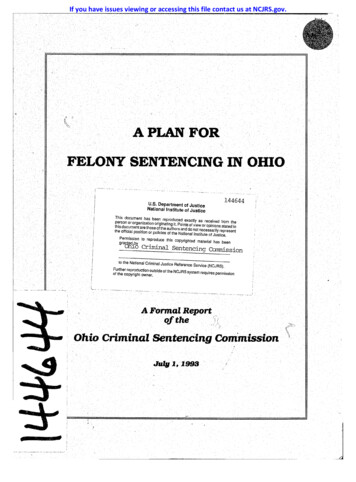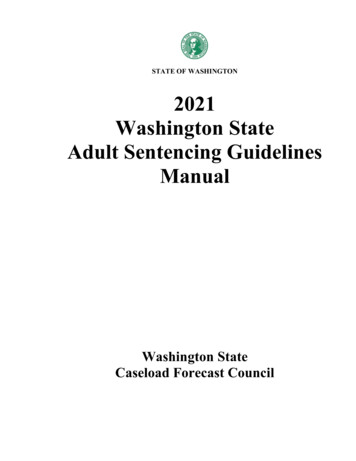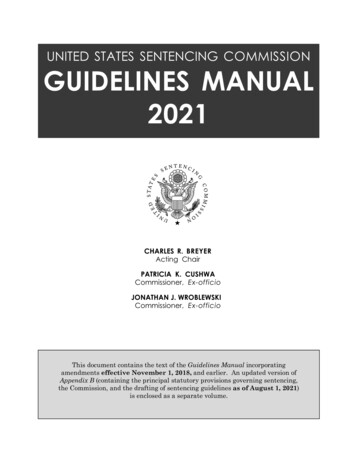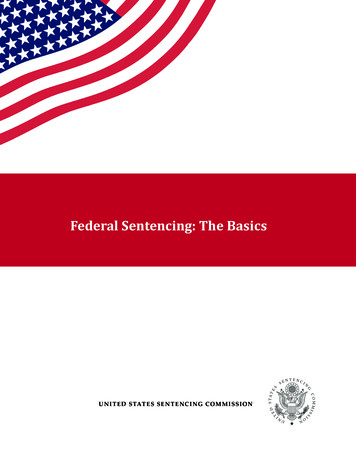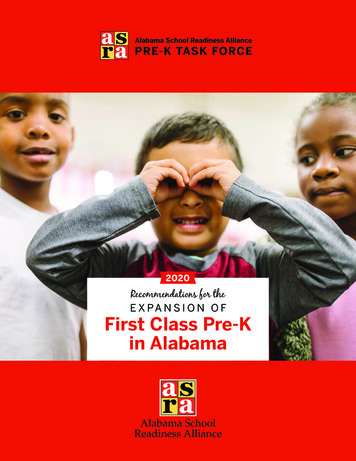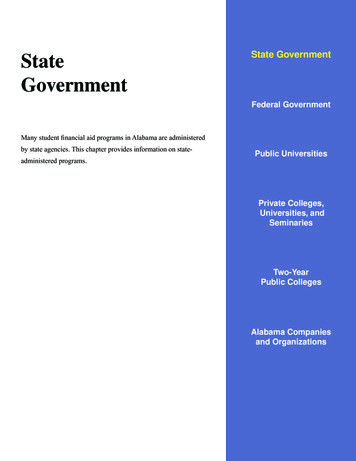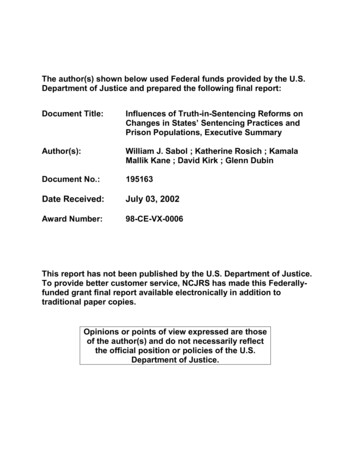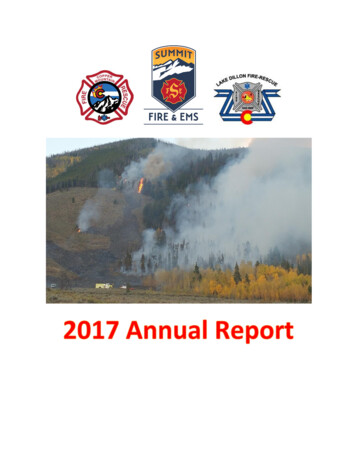
Transcription
ALABAMA SENTENCING COMMISSION, 2017
ALABAMASENTENCINGCOMMISSION2017 Report300 Dexter AvenueSuite 2-230Montgomery, Alabama 36104Phone: (334) 954-50991-866-954-9411 ext.5099Fax: (334) 954-2124E-mail: sentencing.commission@alacourt.govWebsite: http://sentencingcommission.alacourt.gov
ALABAMA SENTENCING COMMISSION, 2017
Table of ContentsAcknowledgementsiAlabama Sentencing Commission MembersiiExecutive Committee MembersiiiAdvisory Council MembersiiiCommission StaffivStandards Committee MembersivLetter from ChairmanviiChapter 1: 2016 - The Year of Implementation1Chapter 2: Sentencing Standards Compliance andCriminal Justice Data3
ALABAMA SENTENCING COMMISSION, 2017
AcknowledgementsThe Alabama Sentencing Commission takes this opportunity to extend its sincere appreciation to the variouscriminal justice agencies, departments and state and local officials for the invaluable assistance and supportthey have provided to the Commission. The successes achieved by the Sentencing Commission have beenaccomplished only because of their consistent dedication, service, and encouragement, which is indicative ofthe extraordinary collaboration between Alabama’s Executive, Legislative and Judicial branches for theimprovement of Alabama’s Criminal Justice System. The commitment to inter-branch efforts has allowed theCommission to focus on its number one priority – public safety.The Commission and staff are grateful for the assistance that has been provided by these individuals in theircommitment to improve public safety in Alabama. Special recognition is extended to the following individualsand organizations for lending their knowledge, expertise and support to the Alabama Sentencing Commission.Governor Robert BentleyActing Chief Justice Lyn StuartChief Justice Roy S. MooreLieutenant Governor Kay IveyDel Marsh, President Pro Tempore, Alabama SenateSenator Cam Ward, Chair, Senate Judiciary CommitteeThe Alabama SenateMac McCutcheon, Speaker of the House, Alabama House of RepresentativesRepresentative Mike Jones, Chair, House Judiciary CommitteeThe Alabama House of RepresentativesJoseph A. Colquitt, Chairman of the Sentencing CommissionRandy Helms, Administrative Director of CourtsAdministrative Office of Courts and staffCourt of Criminal AppealsAlabama Circuit and District Judges’ AssociationsAttorney General Luther StrangeThe Alabama Department of Corrections and staffThe Alabama Board of Pardons and Paroles and staffThe Alabama District Attorneys Association/Office of Prosecution ServicesVictim Advocates; VOCAL, MADD, Angel House, Coalition Against Domestic ViolenceThe National Association of Sentencing CommissionsAlabama Association of Community CorrectionsAlabama Lawyers AssociationThe Criminal Defense Lawyers AssociationThe Association of County CommissionersThe Alabama Sheriff’s AssociationThe Alabama Association of Chiefs of PoliceDr. Tammy Meredith and Dr. John Speir, Applied Research Service, Inc.Wesley Smithart, Emory Universityi
Alabama SentencingCommission MembersAppointed by the Chief Justice of the Supreme CourtRetired Circuit Judge Joseph A. Colquitt, ChairBeasley Professor of Law, University of Alabama School of LawGovernor’s AppointmentsFranklin JohnsonGovernor’s Office, Deputy Chief of StaffMiriam Shehane, Executive DirectorVictims of Crime and Leniency (VOCAL)Victims’ AdvocateJanette GranthamVictims of Crime and Leniency (VOCAL)Victims’ AdvocateAttorney General AppointmentMichael DeanAssistant Attorney GeneralPresident of the Alabama District Attorneys’ AssociationAppointmentsEleanor I. Brooks, Supernumerary District Attorney, 15th Judicial CircuitSteven T. Marshall, District Attorney, 27th Judicial CircuitTom Anderson, District Attorney, 12th Judicial CircuitPresident of the Alabama Association of Circuit CourtJudges’ AppointmentsP.B. McLauchlin, Retired Circuit Judge, 33rd Judicial CircuitTerri Bozeman-Lovell, Circuit Judge, 2nd Judicial CircuitPresident of the Alabama Association of District CourtJudges’ AppointmentClaude E. Hundley, District Judge, Madison CountyChair of the House Judiciary CommitteeRepresentative Mike Jones, House District 92Chair of the Senate Judiciary CommitteeSenator Cam Ward, Senate District 14Alabama Department of CorrectionsJefferson Dunn, CommissionerAlabama Board of Pardons and Paroles’ AppointmentPhil Bryant, Executive DirectorAppointment by the Chief Justice of the Supreme CourtLou Harris, D.P.A., Faulkner UniversityPresident of the Alabama Lawyers Association AppointmentAngeline Sperling, Esquire, Montgomery, ALPresident of the Alabama Criminal Defense LawyersAssociation AppointmentJoel Sogol, Esquire, Tuscaloosa, ALALABAMA SENTENCING COMMISSION, 2017ii
Sheriff’s Association AppointmentScott Lolley, Sheriff, Choctaw CountyAssociation of Chiefs of Police AppointmentTed Cook, Police Chief, Mountain Brook, ALExecutive CommitteeRetired Circuit Judge Joseph A. ColquittBeasley Professor of Law, University of Alabama School of LawEleanor I. Brooks, Supernumerary District Attorney15th Judicial CircuitRetired Circuit Judge P.B. McLauchlin33rd Judicial CircuitJoel Sogol, EsquireTuscaloosa, ALAdvisory CouncilCircuit Judge John W. Cole10th Judicial CircuitDeborah DanielsAlabama Department of Corrections AppointeeTerry DavisChief of Police, Boaz, ALDoris DeaseVictim AdvocateDenis DevaneShepherd’s FoldBill FranklinSheriff, Elmore County Sheriff’s OfficeSteve GreenPresident, Alabama Community Corrections AssociationDirector, Mobile County Community CorrectionsNelson GregoryChief of Police, Geraldine, ALJohn HammDirector, Government RelationsAlabama Law Enforcement AgencySteve Lafreniere, Executive DirectorAlabama Department of Youth ServicesShelly Linderman, Project DirectorVictims of Crime and Leniency (VOCAL)iii
Retired Justice Hugh MaddoxAlabama Supreme CourtChaplin Adolph SouthTuscaloosa, ALJeff Williams, Deputy CommissionerAlabama Department of CorrectionsCommission StaffBennet Wright, Executive DirectorMelisa Morrison, Research AnalystStandards CommitteeBennet Wright, ChairExecutive Director, Alabama Sentencing CommissionDarlene Hutchinson BiehlVictims of Crime and Leniency (VOCAL)Eleanor I. Brooks, Supernumerary District Attorney15th Judicial CircuitBeau Brown, General CounselOffice of Prosecution ServicesPhil Bryant, Executive DirectorAlabama Board of Pardons and ParolesCircuit Judge John W. Cole10th Judicial CircuitMichael Dean, Asstistant Attorney GeneralOffice of the Attorney GeneralJefferson Dunn, CommissionerAlabama Department of CorrectionsCircuit Judge John England6th Judicial CircuitBrandon Falls, District Attorney10th Judicial CircuitJannette GranthamVictims of Crime and Leniency (VOCAL)Micahel Hanle, EsquireBirmingham, ALRalph HendrixUAB Treatment Alternatives to Street Crime (TASC)ALABAMA SENTENCING COMMISSION, 2017iv
Bob Johnston, Assistant District Attorney9th Judicial CircuitCircuit Judge Tim Jolley27th Judicial CircuitMike Jones, ChairHouse Judiciary CommitteeCircuit Judge David Kimberly16th Judicial CircuitJill Lee, District Attorney18th Judicial CircuitSteve Marshall, District Attorney27th Judicial CircuitAlyia McKee, Public DefenderMontgomery CountyRetired Circuit Judge P. B. McLauchlin33rd Judicial CircuitRichard Minor, District Attorney30th Judicial CircuitCircuit Judge Teresa Pulliam10th Judicial CircuitCircuit Judge Robert Smith13th Judicial CircuitJoel Sogol, EsquireTuscaloosa, ALJoe VanHeest, Public DefenderTuscaloosa CountyBob Williams, Public DefenderShelby Countyv
Mission StatementThe Alabama Sentencing Commission shall work to establish and maintainan effective, fair, and efficient sentencing system for Alabama that enhancespublic safety, provides truth-in-sentencing, avoids unwarranted disparity,retains meaningful judicial discretion, recognizes the most efficient andeffective use of correctional resources, and provides a meaningful array ofsentencing options.ALABAMA SENTENCING COMMISSION, 2017vi
ALABAMA SENTENCING COMMISSIONJoseph A. Colquitt, ChairmanBeasley Professor of LawTom AndersonDistrict Attorney, 12th Judicial CircuitTerri Bozeman-LovellCircuit Judge, 2nd Judicial CircuitEllen BrooksSupernumerary District Attorney,15th Judicial CircuitPhil BryantDirector, Bd. of Pardons and ParolesTed CookPolice Chief, Mountain Brook, ALMichael DeanAssistant Attorney GeneralJefferson DunnCommissioner, Dept. of CorrectionsJanette GranthamVictim’s AdvocateLou HarrisFaulkner UniversityClaude HundleyDistrict Judge, Madison CountyFranklin JohnsonGovernor’s OfficeMike JonesHouse Judiciary CommitteeScott LolleySheriff, Choctaw CountySteve MarshallDistrict Attorney, 27th Judicial CircuitP. B. McLauchlinRetired Circuit Judge, 33rd Judicial CircuitIt is my pleasure to present you the Alabama Sentencing Commission’s 2017Annual Report. This report includes information concerning the work of theCommission in the past year and data from the State’s criminal justice system.Following the passage of omnibus “prison reform” legislation last year, muchof the Commission’s time and effort was dedicated to training, education,and implementation of changes to sentencing, probation, parole, and responsesto violations of community supervision.The Commission spent much of the year providing trainings across Alabamaon the recent changes to criminal law and policy. Judges, prosecutors, defenselawyers, probation and parole officers, and community corrections personnelwere provided training on the extensive changes to law and policy. After thepassage of the “prison reform” legislation last year, the Commission andLegislature approved new Sentencing Standards that incorporated thesentencing law changes. The significant changes to the Sentencing Standards,“split” sentencing law changes, and vast changes to probation and responsesto violations of probation and parole required a comprehensive statewidetraining effort that is still ongoing.Information is provided in the Data Chapter including judicial compliancewith the Sentencing Standards, court conviction information, and Departmentof Corrections population, admission and release figures. Approximatelythree years have elapsed since the effective date of the Presumptive SentencingStandards and prison population, admission and release trends have changedincluding the continued shift to a lower percentage of non-violent offenders inthe State prison system.The Alabama Sentencing Commission continues to work to improve publicsafety, and increase the fairness and efficiency of Alabama’s criminal justicesystem. One of the areas the Commission remains committed is accurateand reliable data that is used to inform major policy decisions for the State.We look forward to continuing to help make Alabama safer and improvingthe criminal justice system.Sincerely,Miriam ShehaneDirector, VOCALJoel SogolCriminal Defense Lawyers’ AssociationAngeline SperlingAlabama Lawyers’ AssociationJoseph A. Colquitt, ChairAlabama Sentencing CommissionCam WardSenate Judiciary Committeevii
ALABAMA SENTENCING COMMISSION, 2017viii
Chapter 1: 2016 - The Year of ImplementationThe Alabama Sentencing Commission dedicated much of the past yearhelping implement the omnibus criminal justice legislation passed by theLegislature and signed into law by Governor Bentley in 2015 commonlyreferred to as “prison reform.” However, in addition to significant sentencingchanges, the legislation also focused on improving community supervision,changed responses to technical violations of community supervision andrequired the development of parole guidelines. For more information onthe provisions of the legislation, please reference the Alabama SentencingCommission’s 2016 Annual Report.“Prison Reform”Legislation Enacted in 2015Act 2015-185 was comprehensive legislation that made sweeping changesacross the criminal justice system including requiring the Alabama SentencingCommission to modify the Sentencing Standards. Last year, the AlabamaSentencing Commission submitted modifications to the Sentencing Standardsincorporating the sentencing provisions of the Act. The new set ofSentencing Standards became effective in 2016. The significant changesto criminal law and the Sentencing Standards required extensive trainingthroughout the past year across Alabama. Over the course of the previousyear, the Commission provided numerous trainings throughout the state tojudges, prosecutors, defense lawyers, court clerks, probation and paroleofficers, law enforcement and community corrections personnel. Many ofthe trainings were done in conjunction with the Alabama Board of Pardonsand Paroles highlighting the numerous changes to probation and parolerequirements and supervision, and new authority vested in their officers.New Sentencing StandardsBecame Effective in 2016The training provided this past year was not restricted to the SentencingStandards. In addition to requiring changes to the Sentencing Standards,Act 2015-185 changed the parameters for all Class C and Class D felonysplit sentences, and changed the statutory framework for how all Class Cand Class D felonies must be sentenced. The restrictions on the use ofcustodial sanctions for Class D felonies were highlighted as was the newpolicy framework for responding to technical violations of probation andparole. With the passage of the landmark legislation, the Legislature clearlyaimed to restrict both the use of jail and prison sanctions for offendersconvicted of Class D felonies while still making custodial sanctions availablefor those offenders with a more significant felony criminal history. At thesame time, the Legislature repealed the “technical violator law” and put inits place a new framework designed to curb recidivism through swift andcertain responses to technical violations. This new framework introducednew requirements and restrictions for technical violations of probation andparole, and granted new authority to probation and parole officers to imposeshort term jail sanctions for technical violations as well.Extensive TrainingProvided by CommissionSignificant Changes toCriminal Law andSentencing Standards1
Chapter 1: Modifications to the Sentencing StandardsAlabama CriminalJustice Oversight andImplementation Council#1 Priority is Public SafetyThe Commission has also been active on the Alabama Criminal JusticeOversight and Implementation Council created by Executive Order fromGovernor Bentley. This body is tasked with not only overseeing theimplementation of the omnibus Justice Reinvestment Initiative reforms, butalso developing evidence-based policies and guidelines to help reducerecidivism and improving data collection, analysis, and reporting effortsacross the criminal justice spectrum particularly the courts, Department ofCorrections, and Alabama Board of Pardons and Paroles. One of theCouncil’s subcommittees, the Data Monitoring and Information Sharingsubcommittee, is chaired by Melisa Morrison (Research Analyst for theAlabama Sentencing Commission). The subcommittee has met regularlyidentifying better practices that can be adopted to improve data reportingand provide clear and concise information on Justice Reinvestment inAlabama.The Commission was active this year providing training and participating inefforts implementing extensive changes to criminal law and communitysupervision, and providing assistance improving data efforts in the criminaljustice system. Commission members and staff remain dedicated to theutilization of empirical evidence to make data driven decisions used to enhancepublic safety in Alabama. 2016 witnessed significant changes in Alabamalaw and policy and the Commission will continue to play a pivotal rolehelping supply data and information to shape effective policy and improvethe safety of Alabamians.ALABAMA SENTENCING COMMISSION, 20172
Chapter 2: Sentencing Standards Compliance andCriminal Justice DataThe Commission identified a 4-Stage model used to gauge judicial compliancewith the Initial Voluntary Sentencing Standards1. The first stage in theprocess (Use Compliance) consisted of contacting local practitioners anddetermining how implementation of the Standards was proceeding. Thesecond stage (Submission Compliance) entailed comparing the number ofsubmitted valid worksheets to the number of applicable worksheetsentencing events. The third and fourth stages, In/Out and Sentence LengthCompliance, measured compliance with the dispositional and sentence lengthrecommendations found on the Standards worksheets.Judicial Compliance ModelFor fiscal year 2015, the Commission received valid worksheets in39 percent of applicable cases, but the total number of worksheets receivedwas significantly higher. Practitioners across the State indicated increasedusage of the worksheets in fiscal year 2015 as the Presumptive SentencingStandards were utilized statewide. Commission staff continue to workwith the Information Technology division of the Administrative Office ofCourts to ensure that every worksheet filed with Clerks’ offices across theState is accessible to the Commission.Figure 1 displays the number of total received worksheets in fiscal year2015 and the number of valid received worksheets by county and for theentire State.1For more detailed information about the 4-Stage model and what constitutes avalid worksheet, please see the Commission’s 2009 Annual Report.3
Chapter 2: Sentencing Standards Compliance and Criminal Justice DataFigure 1.Sentencing Standards Worksheets ReceivedOctober 1, 2014-September 30, LABAMA SENTENCING COMMISSION, 8129182811238213222321429047908292151% rksheetsWorksheetsEvents withfor Sentencing for Sentencing Valid 5%44.4%0.0%2.0%4
Figure 1. (Continued)Sentencing Standards Worksheets ReceivedOctober 1, 2014-September 30, organPerryPickensPikeRandolphRussellShelbySt. 17562523142205913,763% rksheetsWorksheetsEvents withfor Sentencing for Sentencing Valid 9.4%62.5%95.5%32.6%67.0%1.3%71.4%0.0%71.2%39.1%5
Chapter 2: Sentencing Standards Compliance and Criminal Justice DataIN/OUT COMPLIANCEFigure 2 is a flowchart displaying the “In/Out” worksheet recommendationsand “In/Out” dispositions for the worksheets for which judicial complianceis reported statewide. This flowchart is organized as follows:Valid Worksheetso Box A - Displays the number of completed and valid worksheetsreceived by the Sentencing Commission used to determine judicialcompliance;Recommended Dispositionso Box B - Displays the number of “In” recommendations from thecompleted worksheets and the percentage of submitted worksheets with aresulting “In” recommendation;o Box C - Displays the number of “Out” recommendations from thecompleted worksheets and the percentage of submitted worksheets with aresulting “Out” recommendation;Imposed Dispositionso Box D - Displays the number of “In” recommendations that receivedan “Out” Disposition. The percentage displayed is the percentage of “In”recommendations that received an “Out” disposition;o Box E - Displays the number of “In” recommendations that receivedan “In” Disposition. The percentage displayed is the percentage of “In”recommendations that received an “In” disposition;oBox F - Displays the number of “Out” recommendations thatreceived an “Out” Disposition. The percentage displayed is the percentageof “Out” recommendations that received an “Out” disposition;oBox G - Displays the number of “Out” recommendationsthat received an “In” Disposition. The percentage displayed is the percentageof “Out” recommendations that received an “In” disposition.Box A shows the starting number of valid worksheets used to report judicialcompliance – 5,318 worksheets. The “In/Out” recommendations reflectthe Prison vs. Non-Prison recommendation based on the total score of the“In/Out” worksheet. An “Out” disposition was recommended in 53 percentof the received worksheets and an “In” disposition was recommended in47 percent of the received worksheets. For those worksheets with an“In” recommendation, an “In” disposition was imposed 88 percent of thetime (Box E). For those worksheets with an “Out” recommendation, an“Out” disposition was imposed 81 percent of the time (Box F).ALABAMA SENTENCING COMMISSION, 20176
The shaded boxes (Boxes E and F) indicate sentencing events that were“In/Out” compliant - that is a “prison” sentence was imposed for an “In”recommendation, or a “non-prison” sentence was imposed for an “Out”recommendation2. Figure 3 provides examples of combinations of worksheetrecommendations and case dispositions to show where sentencing eventsare categorized on the In/Out flowchart.Figure 2.In/Out Compliance FlowchartAWorksheetsReceived forSentencing Eventsn 5,318CBINRecommendationn 2,50847.2%DOUTDispositionn 890123456789n 56789OUTRecommendationn 6789012345678901234567890n 1234567890GINDispositionn 53819.1%2For the purpose of determining compliance only, an imposed communitycorrections sentence was categorized as In/Out compliant regardless of theworksheet In/Out recommendation (see Figure 3 for examples).7
Chapter 2: Sentencing Standards Compliance and Criminal Justice DataFigure 3.In/Out Compliance estinationIN/OUTCompliantINProbationBox DNoINCommunityCorrectionsBox EYesINJailBox DNoINPrisonBox EYesOUTProbationBox FYesOUTCommunityCorrectionsBox FYesOUTJailBox FYesOUTPrisonBox GNoALABAMA SENTENCING COMMISSION, 20178
Figure 4.Offense Category Compliance FlowchartsAPersonaln 484CBINRecommendationn 34771.7%DOUTRecommendationn 13728.3%FEOUTDispositionn 234567890123456789012345678901234567890n tion12345678901234567891234567890123456789n 89GINDispositionn 5338.7%AFigure 5.Propertyn 2,186CBINRecommendationn 1,04147.6%DOUTDispositionn 901234567890123456789012345678901234567890n ationn 5678901234567891234567890123456789n 5678901234567891234567890123456789GINDispositionn 21819.0%9
Chapter 2: Sentencing Standards Compliance and Criminal Justice DataFigure 6.Offense Category Compliance Flowcharts (Continued)ADrugsn 2,648CBINRecommendationn 1,12042.3.%DEOUTDispositionn 90123456789n nn 678901234567890123456789012345678901234567890n tionn 26717.5%Figure 4 reports the In/Out compliance for the personal worksheet category,Figure 5 reports the In/Out compliance for the property worksheet category,and Figure 6 reports the In/Out compliance for the drug worksheet category.The Personal worksheet has the highest compliance with “In”recommendations at 93 percent of offenders receiving a prison sentencefor a corresponding “In” recommendation. The Drugs worksheet had88 percent compliance with “In” recommendations while the Propertyworksheet had 87 percent compliance with “In” recommendations. ThePersonal worksheet, while having the highest compliance with “In”recommendations, had the lowest compliance with “Out” recommendationsat 61 percent. The Property and Drugs worksheets had 81 and 83 percentcompliance with “Out” recommendations, respectively.ALABAMA SENTENCING COMMISSION, 201710
Race & Gender Compliance ChartsFigures 7 and 8 provide statewide compliance with the Sentencing Standardsby race and gender, respectively. Compliance data with the Standardsshow similar compliance rates for Black and White offenders. The “Other”category consists of a small number (n 48) of offenders representingnumerous racial groups. While no large disparity is found in the compliancefigures controlling for race, the overall compliance percentage for femalesis higher than for males.Figure 7.RaceOverallIn/OutBlack75.3%85.6%n 2,390White76.5%83.1%n 2,880Other75.0%83.3%n 48Figure 8.GenderOverallIn/OutFemale82.6%86.0%n 1,108Male74.2%83.8%n 4,21011
Chapter 2: Sentencing Standards Compliance and Criminal Justice DataSENTENCE LENGTH COMPLIANCESentence Length compliance is measured by comparing the term(s) ofconfinement to the recommended term(s) of confinement found on theSentence Length sentencing worksheet. For an imposed direct/straightprison sentence, the length of imposed confinement is compared to the“straight” recommended sentence range found on the Sentence Lengthworksheet. For an imposed split sentence, the split portion and the totalsentence lengths are compared to the split and straight Sentence Lengthrecommended sentence ranges found on the Sentence Length worksheet.For a direct/straight sentence to be Sentence Length compliant, the imposedconfinement must fall within the “straight” Sentence Length range foundon the worksheet. For a split sentence to be Sentence Length compliant,the split portion of the sentence and the total length portion of the sentencemust both be within the “straight” and “split” ranges found on the worksheet.Sentence Length compliance is only reported for those sentencing eventswhere the worksheet recommendation was “In” and the sentencing eventalso had a corresponding “In” disposition (those events located in Box E ofthe In/Out flowchart). 2,209 worksheet sentencing events received an“In” recommendation and an “In” sentence and are used to report sentencelength compliance (those in Box E).The diagram (Figure 9) on the following page displays statewide SentenceLength compliance using four categories - Within, Below, Above, and Mixed.The “Mixed” category is applicable only to split sentences when the differentportions of the sentence (incarceration and total portions) are not consistentwith each other. Instances when the incarceration portion is above therecommended range and the total portion is below the recommended range,or the incarceration portion is within the recommended range and the totalrange is above the recommended range are examples of split sentencesthat would fall in the “Mixed” category. If both the split and total portionsare within, above, or below the worksheet sentence length recommendations,they would be categorized as such, if they are not, they are categorized as“Mixed”. 80 percent of eligible sentencing events were sentence lengthcompliant, 11 percent of the sentencing events received sentences abovethe worksheet recommendations, 1 percent received sentences below theworksheet recommendations, and 8 percent fell in the “Mixed” category.The overwhelming majority of events in the “Mixed” category consisted ofsentences when the incarceration portion of the split sentence fell withinthe recommendations, but the total sentence exceeded the recommendations.The three pie charts, F
Wesley Smithart, Emory University. ALABAMA SENTENCING COMMISSION, 2017 ii Alabama Sentencing . District Attorney, 12 th Judicial Circuit President of the Alabama Association of Circuit Court . Bennet Wright, Executive Director Melisa Morrison, Research Analyst Bennet Wright, Chair .
